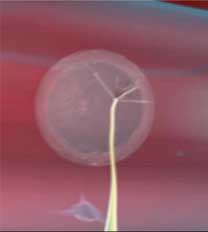


Investigators and Projects
Experimental autoimmune uveoretinitis (EAU) serves as an animal model for human inflammatory eye disease. It is thought that on-induction of EAU autoaggressive antigen-specific T cells activated systemically home to the eye and encounter antigen presented by local antigen presenting cells (APCs). These activated T cells produce cytokines and chemokines including interferonγ (IFNγ) and tumour necrosis factorα (TNFα) which attract macrophages, granulocytes and further T cells which infiltrate retinal tissue. These infiltrating macrophages and granulocytes cause destruction of the retina by the release of reactive oxygen species and nitric oxide.
The T cells responsible for EAU are thought to be CD4+ T helper (Th)1 cells. However, disease is exacerbated in the absence of either of the Th1 cytokines IFNγ or IL-12, and ameliorated when treated with IFNγ. One explanation for this is that there is a reciprocal relationship between pathogenic IL-17 producing CD4+ cells (Th17) and cells that produce IFNγ (which negatively regulate Th17 differentiation). In other models Th17 cells play a key role in pathology, but their relevance to EAU has not yet been established.
The standard method for assessment of EAU is histological examination of the eye to discern structural damage and immune cell infiltrate. We have developed a flow cytometric method for investigation of diseased eyes to study the kinetics of EAU further. This technique allows a much more extensive analysis of cell infiltrate to be carried out in a shorter time, and it may also be a more sensitive method of analysis.
Using this method we can count the absolute numbers of different infiltrating cell populations in diseased eyes. This has allowed us to visualise the changes in numbers of T cells, macrophages and other immune cells during the disease process. Current research uses intracytoplasmic staining for IFNγ, IL-17 and IL-10 to assess the relative contribution of different T helper cells during different stages of the disease process such as peak disease and resolution.
Copland, D.A., Liu, J., Schewitz-Bowers, L.P., Brinkmann, V., Anderson, K., Nicholson, L.B., Dick, A.D. (2012) Therapeutic Dosing of Fingolimod (FTY720) Prevents Cell Infiltration, Rapidly Suppresses Ocular Inflammation, and Maintains the Blood-Ocular Barrier
American Journal of Pathology 180: 672-681.
Raveney, B. J. E., Copland, D. A., Nicholson, L. B., and Dick, A. D. (2008)
Fingolimod (FTY720) as an acute rescue therapy for intraocular inflammatory
disease.
Kerr, E. C., Raveney, B. J. E., Copland, D. A., Dick, A. D., and Nicholson, L.
B. (2008). Analysis of Retinal Cellular Infiltrate in Experimental Autoimmune
Uveoretinitis Reveals Multiple Regulatory Cell Populations.
J. Autoimmunity 31, 354-361
DOI:dx.doi.org/10.1016/j.jaut.2008.08.006